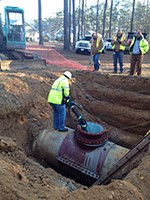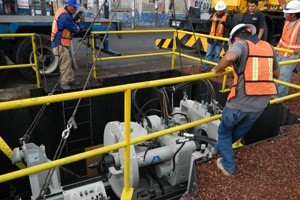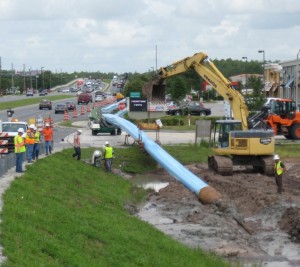Uncategorized
 Cobb County-Marietta Water Authority (CCMWA) is the second largest drinking water supplier in Georgia, providing vital service to nearly 800,000 people through twelve wholesale customers. With two award-winning water treatment plants and over 200 miles of large-diameter transmission mains, CCMWA can deliver up to 158 million gallons per day. Two of CCMWA’s key objectives are to be financially viable and to reduce vulnerabilities by improving redundancy and implementing a comprehensive asset management program.
Cobb County-Marietta Water Authority (CCMWA) is the second largest drinking water supplier in Georgia, providing vital service to nearly 800,000 people through twelve wholesale customers. With two award-winning water treatment plants and over 200 miles of large-diameter transmission mains, CCMWA can deliver up to 158 million gallons per day. Two of CCMWA’s key objectives are to be financially viable and to reduce vulnerabilities by improving redundancy and implementing a comprehensive asset management program.
However, across the United States critical infrastructure is aging, causing utilities to see an increased number of water pipe failures. While these failures occur most commonly on small pipes – causing only minor disruptions – large-diameter mains do fail, resulting in major delays and enormous repair bills.
A large portion of CCMWA’s large-diameter pipeline inventory is made up of Prestressed Concrete Cylinder Pipe (PCCP). In order to successfully manage PCCP, the water industry has widely adopted the use of condition assessment techniques, which have a proven track record of identifying and averting PCCP failures. PCCP owners and operators continue to use these condition assessment methodologies combined with sound engineering analysis to effectively and safely manage their critical assets.
Cobb County’s Program
In 2012, CCMWA was in a similar situation to many predominant PCCP users; past failures on these critical assets had led to the decision to replace the majority of PCCP assets to avoid the risk of future failures. However, it was determined that replacing large sections of pipeline was not financially or logistically feasible.
Large-scale replacement programs are also unnecessary based on industry research, which confirms that pipe deterioration is not uniform or systematic. Specifically, electromagnetic inspection data (which identifies both the quantity and location of broken prestressing wires – the primary structural component of PCCP) collected by Pure Technologies over more than a decade indicates that less than 4 percent of pipe sections inspected have any level of wire break damage and less than 1 percent require repair – regardless of when it was manufactured.
photo caption:
Staff remove the PipeDiver tool after the non-destructive assessment.
Uncategorized
In mid-October 2013 , construction was finalized on the installation of 2,944 ft. (897m) of new 36-in. (914mm) ID storm and sanitary pipelines using pilot tube guided boring methods in Mexico City. The Subcolector San Marcos project, owned by La Comisión del Agua del Estado de México (CAEM), represents the first trenchless installation with this technique in Mexico. The Subcolector San Marcos project embodies the successful and accurate completion of the alignments, but more importantly, the culmination of several years of partnerships to educate, design, and procure equipment and pipe among many entities. Crews installed the total 2,944-ft. (897m) in eight drives, ranging from 186 to 441-ft. (57-134m) in length, from nine minimal depth and diameter shafts in the urban Plaza de Aragon, Ciudad Nezahualcóyotl municipality of Mexico City. More information about this project can be gleaned during our presentation, WM-T4-05, at NASTT’s 2014 No-Dig Show.
, construction was finalized on the installation of 2,944 ft. (897m) of new 36-in. (914mm) ID storm and sanitary pipelines using pilot tube guided boring methods in Mexico City. The Subcolector San Marcos project, owned by La Comisión del Agua del Estado de México (CAEM), represents the first trenchless installation with this technique in Mexico. The Subcolector San Marcos project embodies the successful and accurate completion of the alignments, but more importantly, the culmination of several years of partnerships to educate, design, and procure equipment and pipe among many entities. Crews installed the total 2,944-ft. (897m) in eight drives, ranging from 186 to 441-ft. (57-134m) in length, from nine minimal depth and diameter shafts in the urban Plaza de Aragon, Ciudad Nezahualcóyotl municipality of Mexico City. More information about this project can be gleaned during our presentation, WM-T4-05, at NASTT’s 2014 No-Dig Show.
Thank you to Akkerman for providing this content and photo.
Uncategorized
 The TOHO Water Authority (TOHO) has been acquiring and integrating water utility systems in Osceola County near Orlando, FL. As part of that growth, a 24-inch interconnect in Kissimmee, FL was required to provide adequate redundancy in the system. The route of the 24” water main required a key crossing at the Florida Turnpike. After evaluation of alternatives, the design team including CPH, Inc. and TOHO concluded on a single horizontal directional drill (HDD) installation as the most practical solution to cross the highway. The FDOT Turnpike office required encasement for the pipeline within their right-of-way, including minimum depth requirements, which in turn drove the required size of the casing, bore hole, and ultimately the depth required for the crossing.
The TOHO Water Authority (TOHO) has been acquiring and integrating water utility systems in Osceola County near Orlando, FL. As part of that growth, a 24-inch interconnect in Kissimmee, FL was required to provide adequate redundancy in the system. The route of the 24” water main required a key crossing at the Florida Turnpike. After evaluation of alternatives, the design team including CPH, Inc. and TOHO concluded on a single horizontal directional drill (HDD) installation as the most practical solution to cross the highway. The FDOT Turnpike office required encasement for the pipeline within their right-of-way, including minimum depth requirements, which in turn drove the required size of the casing, bore hole, and ultimately the depth required for the crossing.
“24” DR18 Fusible C-905® carrier pipe and 30” DR21 Fusible PVC™ casing offered the only practical pipe material option for this specific application”, commented project engineer, Jay Morris, P.E.. Jay added, “The high hydrostatic design basis (HDB) of Fusible PVC™ enabled us to minimize the OD of the casing pipe and the corresponding depth of the bore alignment, in accordance with FDOT guidelines”.
| Pipeline Details and Project Summary |
| Project: |
Osceola Parkway – Florida Turnpike WM Crossing |
|
Location:
|
Kissimmee, FL |
| Length: |
1,500’ |
| Pipe Size: |
30” DR21 FPVC® Casing, 24” DR18 Fusible C-905® Carrier |
| Pressure Test: |
Casing – 65 psi; Carrier – 150 psi |
| Installation: |
Casing Pipe – HDD, Carrier Pipe – Slipline |
| Owner: |
TOHO Water Authority |
| Engineer: |
CPH Inc. – Jay Morris, P.E. |
| Contractor:
HDD Contractor: |
Andrew Sitework, LLC – Ralph Andrew
Accurate Drilling Systems(ADS) – Lauro Acevedo |
| UGSI Contact: |
Robert Tatum (941) 320-2440
rtatum@undergroundsolutions.com |
Ralph Andrews, the GC on the project said, “the technical, fusion and construction support from Underground Solutions, Inc. (UGSI) contributed to smooth and straight forward project execution”. “We had a tight construction schedule and we completed the project on schedule, he added.
Thank you to Underground Solutions, Inc. for providing this content and photo.
 Cobb County-Marietta Water Authority (CCMWA) is the second largest drinking water supplier in Georgia, providing vital service to nearly 800,000 people through twelve wholesale customers. With two award-winning water treatment plants and over 200 miles of large-diameter transmission mains, CCMWA can deliver up to 158 million gallons per day. Two of CCMWA’s key objectives are to be financially viable and to reduce vulnerabilities by improving redundancy and implementing a comprehensive asset management program.
Cobb County-Marietta Water Authority (CCMWA) is the second largest drinking water supplier in Georgia, providing vital service to nearly 800,000 people through twelve wholesale customers. With two award-winning water treatment plants and over 200 miles of large-diameter transmission mains, CCMWA can deliver up to 158 million gallons per day. Two of CCMWA’s key objectives are to be financially viable and to reduce vulnerabilities by improving redundancy and implementing a comprehensive asset management program.

